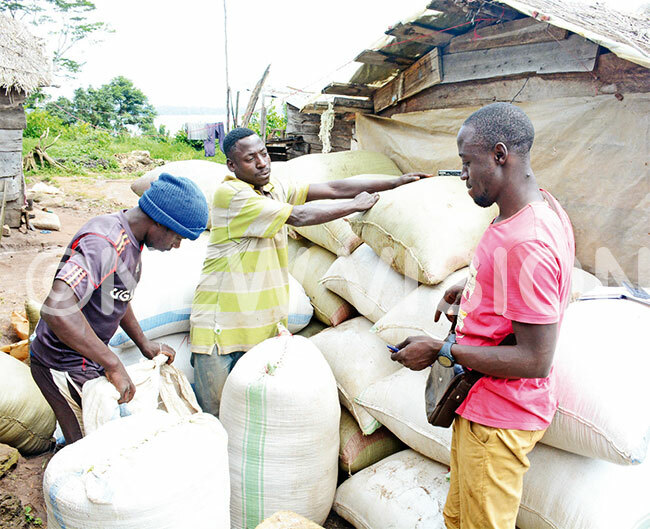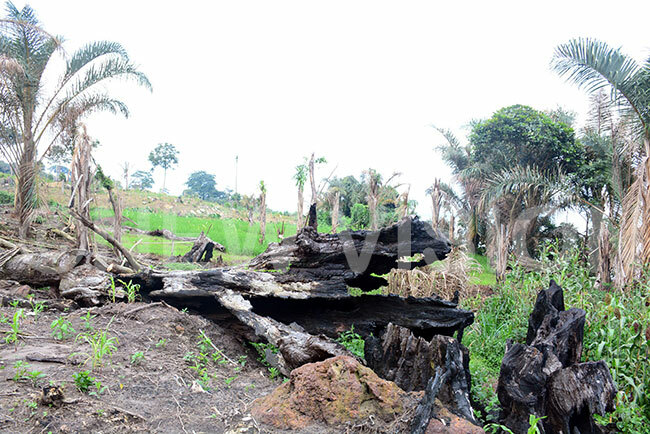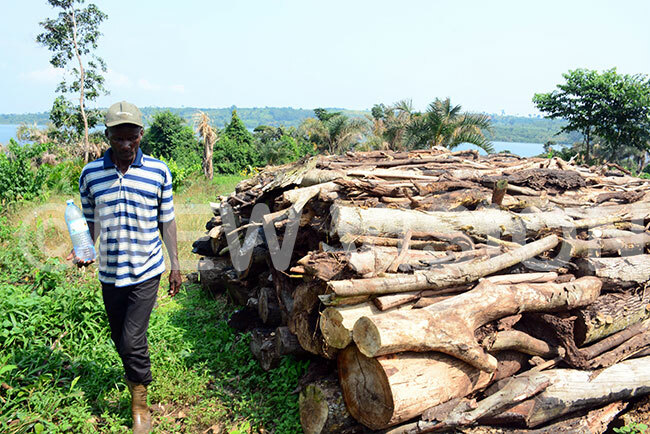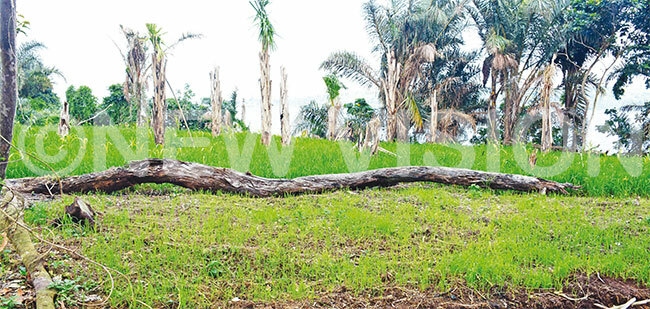Migrants grab 9 islands in L.Victoria, wipe out forests
Of the 84, at least 63 islands are habitable. What welcomes you at Sanyu (happiness) landing site on Buyovu Island are rickety temporary structures built out of wood, grass and polythene sheets, looking similar to a refugee settlement.
CONSERVATION CLIMATE CHANGE
It is a one-and-a-half-hour ride from the main island of Bugala to Buyovu, one of the 84 islands that make up Kalangala district, located approximately 60km across the water, southwest of the Entebbe International Airport.
Of the 84, at least 63 islands are habitable. What welcomes you at Sanyu (happiness) landing site on Buyovu Island are rickety temporary structures built out of wood, grass and polythene sheets, looking similar to a refugee settlement.
By way of appearance and common language spoken, most of the residents here are foreigners.
They commonly speak Kinyarwanda, Swahili, Lingala and other dialects not common in Uganda.
It was one of the islands with least inhabitants, a handful of landowners, the majority of whom live either in Kampala, Entebbe or Masaka. The biggest part of the island was forests, with rare tree species and thickets that were valued for their medicinal value by mainly traditional herbalists and healers, who host clients from as far away as Kampala. Many caves up to today, serve as seasonal worship places for traditionalists. The 1991 national population census estimated that Kalangala had a total population of about 6,400 inhabitants, but by 2002, the number had grown to approximately 34,800.
Ten years later, in 2012, it was estimated that the population had risen to about 66,300, but
there were fears that the number could have doubled by 2019, given the speed at which new settlers were finding space on the island and on several other hitherto unhabitable islands.
 Dealers packing unprocessed rice at Sanyu landing site on Buyovu Island in Kalangala district on Tuesday last week
Dealers packing unprocessed rice at Sanyu landing site on Buyovu Island in Kalangala district on Tuesday last week
Who are these people?
Ezekeli Ndayamba emerges from his hut, holding sugarcane. Three of his children play around and his wife peeps through the doorway, suspicious of the ‘visitors'.
With a smile and speaking in Kinyarwanda and some broken Luganda, Ndayamba says he
is a Rwandan national who came from Busanze, one of the highly populated localities in the southern province of Rwanda. He cannot explain well when he arrived here, but he says he came purposely to grow upland rice, the major variety grown on the island. A scan through the dotted structures here reveals that everyone here is a farmer.
Some were resting on their verandahs and we were told that others were still in the fields, harvesting. Rice dealers can be seen around. Bare-chested men are seen weighing unprocessed rice and packing it in sisal bags, while others are taking advantage of the early afternoon hot sun, to winnow the rice, fresh from harvest. And this looks like a business everyone on the island engages in.
Rice growing is big business on the island and, to give it uniqueness, many of the growers know former vice-president Prof. Gilbert Bukenya, who they credit for having introduced the variety here.
 Trunks of trees remain standing in what used to be thick forests at Buyovu Islands
Trunks of trees remain standing in what used to be thick forests at Buyovu Islands
Another resident, Emmanuel Mugisha, rests his arm on a huge burnt tree stump, supposed to have been one of those precious trees in the forest, that have been cleared in a space of one or two years.
Mugisha, who claims to have come from Kisoro in southwestern Uganda says he learnt about the rice-growing business on the island from fishermen, who found it an alternative livelihood after the army intensified operations across Lake Victoria in an effort to stop illegal fishing.
"I learnt from former fishermen that there was free land here. At home, we live on small plots of land. I now have five acres of rice and I harvest at least three to four tonnes per season," he says.
Emmanuel Bigirimaana, another Rwandan, said he came alongside eight other Rwandans and settled on the island. He came together with his wife and they spend most of the time in the fields, either harvesting or clearing more land for cultivation.
The land is becoming scarce day after day and many of them have established gardens on the lakeshores, almost into the water.
Another man, Robert Habyarimana, also claims to have come from Kisoro. However, he is hesitant to reveal details of his birthplace. He says rice growing is a good venture since one is able to harvest, at least twice a year: Between April and July and plant again in August.
From one acre, Habyarimaana harvests 10 bags, each estimated to weigh between 75kg and 80kg. He says there are several of his colleagues who have settled on other islands since the business is lucrative.
From his narration, it is not known how many new settlers are coming in to exploit the opportunities, but stories of Special Forces Command soldiers chasing settlers from some small and islands valued for their environment were rife on the island. Some confess they were repulsed from elsewhere.
 A resident walks past logs that have been piled for charcoal burning
A resident walks past logs that have been piled for charcoal burning
Former forests now farmlands
Similar activities are going on at Bufumira, Funve, Buyaba, Bukasa, and Bunyazi, among other islands, according to a transporter on Lake Victoria. He says three years ago, what used to be thick forests are now fields of rice and other crops.
According to sources, Rwandan nationals make up the majority of settlers on the islands, followed by the Congolese, Kenyans, Burundians and a few Ugandans.
Another source says many of the people are fishermen who came to fish on Lake Victoria, but following intensified operations against illegal fishing activities in the district, many fishermen were banned from the waters of Lake Victoria. Kalangala district council also banned several fishermen after they were found using illegal fishing gear.
The closure of various landing sites was the reason many fishermen decided to settle on nearby islands, including Buyovu.
Grace, one of the residents and her brother who was a fisherman, settled here, after they were banned from fishing in 2017 and later joined him to grow rice.
"The banning of illegal fishing was a blessing in disguise because it gave my brother an opportunity to get land here. He is the one who invited me to grow rice," she says.
Patrick Seruwagi, another resident, says when he was chased off the lake, he was advised by a friend that there was free land for farming on Buyovu Island.
When he visited the place, it was all forest. He noted that at the time, there was a caretaker who was charged with protecting the area on behalf of the landlord, who he said was residing in Kampala.
"He asked us to clear all the trees to pave the way for farming. I cut trees for timber and also burnt charcoal, which I sold to traders from Kalangala. After clearing the land, I started growing rice," he says.
Seruwagi today has three acres of rice without a tree on the land, apart from tree stumps that have already dried up. To prevent the stumps from sprouting again, he decided to burn them.
A walk across Buyovu Island, one comes across stumps of trees and huge logs lying abandoned in the middle of gardens, which used to be a thick forest, while a distance away, people are cutting down more trees to pave the way for other activities.
Climate change and deforestation
In some other parts, people are heaping tree logs preparing to burn them for charcoal. Clearly, to them, the activities are not anything to worry about. Yet, according to some residents, when they came to the island four years ago, they used to receive frequent rains, but, shockingly, this year, they have experienced a dry spell.
"We heard that the dry spell was caused by the destruction of forests. However, most residents here are illiterate and do not know the importance of conserving forests," one of the residents says.
Yoweri Byaruhanga, a rice farmer on the island, says to grow upland rice, one has to clear all the trees because the crop performs better in open fields. So, farmers have to clear the land before planting.
Asked who gives them permission to cut down trees, many say a manager who allocated them the land for farming allowed them to clear the trees, provided they cut them into timber and share the money with him.
"We thought he was the owner of the land. So, we had to comply with what he was telling us. Since most of us came to the island to do farming, it was also mandatory for us to cut down trees to pave the way for farming," another resident says.
On the lakeshore, most of the vegetation has been cleared, leaving the lake with no protection. Evelyn Namaganda, another resident, says she came to the island after a tip-off from a friend. She explains that upon arrival, she was allocated two acres of land, but all the trees had already been cleared.
"I started growing rice because the forests had already been cleared. I harvest 20 bags every season and sell each kilogramme at sh1,000 to traders from Entebbe and Masaka," she says.
Emmanuel Mugisha, a rice farmer on the island, says as a result of growing crops along the lakeshores, whenever there is rainfall, it is common to see soil being washed into the lake.
Mugisha says leaders sensitised the residents about the dangers of growing rice on the lakeshores, but they have ignored the advice because the shores are ideal for the growing of rice.
Absentee landlord to blame?
Omutaka William Katonya Kamanyiro, a landlord on Bubeke Island, says like Buyovu Island, many islands in Kalangala have been encroached upon. What used to be a forest that people feared to go through, is no more, in just three years.
"This is worrying because there are many more islands that are at risk of being encroached upon. We hear that the encroachers were fishermen who were chased away from the lake because of illegal fishing, but decided to settle on isolated islands in Lake Victoria," he says.
He adds that if the Government does not come up urgently to protect the wetlands, all the natural vegetation is likely to be depleted.
"We do not know if these people have permits allowing them to stay in Uganda. The Government should carry out operations to find out who they are and why they are settling here illegally," Kamanyiro says.
Daniel Kikoola, the Kalangala resident district commissioner and former district chairperson, says it is true there is need for government intervention if the Kalangala Islands are to be preserved.
He, however, says the encroachment is because the landlords on most of the islands are absent.
They delegate people to take care of their land and they never take time to visit. He said it is those given powers to manage the land that give away or hire out forest land to squatters.
"Landlords should ensure that they frequently visit their land. This will prevent illegal squatters from encroaching on the land. They should sit with encroachers and forge the way forward, as well as give them guidelines on how to protect the environment," Kikoola said.
 Almost all the trees have been cut down to create space for growing rice
Almost all the trees have been cut down to create space for growing rice
District efforts curtailed by lack of funds
He added that as a district, they have tried to control deforestation and often, his office has carried out operations that have seen many forest destroyers arrested and prosecuted. Maurice Bafiirawala, the senior environmental officer of Kalangala district, says the district has sensitised the people about dangers of felling down trees and why they should preserve nature and protect the lake.
However, he says they are constrained by the lack of resources.
"Kalangala comprises 84 islands yet the manpower is not sufficient. Transport to cover all these islands in case of emergency operation is too expensive, yet the forest officer has a small budget," he says.
Bafiirawala says as a district, they have put in place measures restricting people to growing rice 200m away from the lakeshores.
The farmers are also advised to work hand in hand with landlords, to ensure that they give them guidelines, which are submitted to the forest officer for approval before they start growing any crop on the island.
Other islands, according to Bafiirawala, that have faced forest destruction by encroachers, are Bukasa, Bugaba, Bunjazi, Bufumira, Bubende, Bunyama, Funve, and Bugala.
Strategy to preserve the island
To curb environmental degradation on Kalangala islands, Ssese Island Nature Conservation and Tourism Association, a community-based organisation formed in 2009, has started efforts to ensure that they preserve the forests on the islands.
Margaret Sempagama Nalwoga, a member and also a landowner, says the association has a total of 71 landowners and it is registered with Kalangala district local government.
She says their main aim is to promote responsible management of the remaining patches of privately owned natural forests. Currently, the association is encouraging people to plant trees and promote tourism, among other activities.